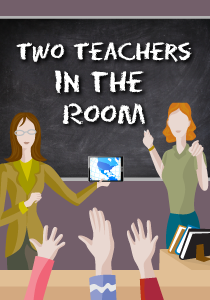4 Critical Co-Teacher Conversations
Editor’s note (October 2021): Elizabeth’s reflection on the promise and challenges of co-teaching continues to be a sought-out post here at MiddleWeb. We hope it will inspire co-teachers to continue pressing for full status and partnership in their classrooms and schools. See all of her co-teaching columns here.
A MiddleWeb Blog
I always knew co-teaching gathered like-minded thinkers who share a similar vision, and our discussion so far supports this reassuring fact.
Thanks to all who are visiting, posting, and taking a part in pushing our thinking forward. Your perspectives add a lot of value to this blog and they offer the opportunity for us to take our discussions to new levels!
I recently read a quote from the 2012 National Teacher of the Year, Rebecca Mieliwocki. She says that teaching is a team sport.
That means we can’t just row on our own. We need to row together in the direction of something bigger. I have to talk to you, I have to learn from you, I have to listen to you, I have to say difficult truths to you at times, and you to me.”
Her view clearly supports teaching in general, and easily resonates with co-teaching as well. As we think about the value derived when co-teachers achieve a shared outlook on teaching, it just makes sense that listening to one another is the first step to ensure a smooth journey.
And while we’re on this journey, we have to include “difficult truths” that may be spoken to one another in an effort to iron out the wrinkles in the educational process.
Drawing energy from difficult truths
Of course, grappling with difficult truths is the most difficult thing to do. After all, who wants to discuss a difficult truth when one can just carry on and avoid it? I know I am not alone when I say, I do!
It’s obvious that avoiding difficult truths (those elephants in the room) will only lead to status quo teaching, at best. And status quo teaching is just not good enough. We must strive and reach beyond the status quo. When we reach the place where all difficult truths are on the table, we can put all of our energy into doing what needs to be done for students.
My most successful co-teaching relationships have been when my co-teachers and I have made the time to create lesson plans, discuss student progress, and figure out our own personal strengths and weaknesses.
Some difficult truths have come into play when we discussed the need to adjust the instructional pacing, rethink some specific instructional strategies, or develop the sensitivity needed to guide diverse thinkers to learn within a positive classroom environment.
But once that kind of open and constructive co-teaching relationship is established, the rest falls into place. And those “difficult truths” help drive a powerful personal and professional growth for all.
4 elephant-in-the-room conversation starters
Let’s face it: we know that not everyone will reach this pinnacle of positive communication. But here are a few things that all teachers can discuss to keep the co-teaching partnership on an upward swing:
1. We can gather and discuss resources about co-teaching – Over time we will uncover many valuable co-teaching resources. One I’d like to offer now outlines five models of effective co-teaching that teachers should use to ensure that they are indeed sharing the planning and responsibilities.
2. We can talk about personal strengths and weaknesses – Teachers should discuss specific roles that each will be responsible for. What parts of the planning and instructional phase will each teacher take charge of? How can each teacher support the other in ways that guide students to achieve?
3. Discuss ways to stay flexible and proactive – Co-planning lessons ahead of time is a must—and so is the need to stay flexible and make appropriate adjustments while we’re in the act of teaching. Teachers should remain connected during the instructional time so they support students all along the way. In addition, teachers must use the information they gain from students’ performance to plan for future lessons.
4. Discuss the learning environment – Co-teachers must discuss the learning environment. What classroom procedures will ensure a positive learning experience? How do the personalities of each teacher contribute to creating optimal learning for students and ourselves? How can each teacher support the other in making the learning exciting and meaningful?
The bottom line, I think, is for every teacher in a co-teaching environment to do what it takes to maintain the commitment, passion and energy required to keep communication flowing and make learning matter.
Looking forward to your connections, questions, comments, and contributions as we continue our journey together. What would you add to my list of critical discussion topics?




































Elizabeth, I love this outline of the 5 models of effective co=teaching. It’s something my teaching partners and I use a lot when we co-plan. Do folks have favorites from this outline or ones they use more frequently? I love parallel teaching when it can be done, and station teaching. My math and ELA partners use station teaching a lot prior to a test to help kids review, as well as when we read novels in ELA class.
When Elizabeth mentions the need to examine personal strengths and weaknesses, I know this can be intimidating. I love science for example, but am terrible at the physical science standards. I am honest with my science partners when we co-plan: I can’t be the teacher who the kids count on to be clear on colloids and suspensions, or the phases of the moon, but I can help the kids with the biology/life science standards. I defer to my partner when kids have confusion with areas I am confused about.
In ELA I love teaching writing but always was challenged with grammar. When we co-plan it’s important to share what we can bring to the teaching partnership. Each week, each unit, each lesson may be different depending on our own strengths and weaknesses.
I’d like to hear folks thoughts on Elizabeth’s comments about their learning environments and routines. What routines are working well for you and your teaching partners? What are some of your favorite and exciting ideas?
Also, I loved Rebecca’s interview and found myself relating to many of her comments and feelings about being a middle school teacher. Were there thoughts that resonated with folks?
There’s another interesting review with NTOY Rebecca Mieliwocki at Education Week Teacher. Here’s the link: http://bitly.com/R21rbt
Great post, Elizabeth – and timely. I’ve heard co-teaching use in a number of different ways: sometimes both teachers are in the room all the time. Sometimes they alternate days or weeks (not in elementary school, I’d be willing to bet). Sometimes teachers split up the kids and to to different rooms, or work with them on different things in the same room. (I may have missed that discussion in an earlier post.)
The whole concept of co-teaching makes a lot of sense and I can think of a million pluses. I’m thinking of the great STEM lessons you could plan and implement . . . wow!
I look forward to your blog!
Anne
It’s so great to see our conversation unfolding. Laurie, I enjoyed reading about your connections. Thanks, John for adding another link to the Education Week article about NTOY Rebecca Mieliwocki (I just love reading about her!). Also, Anne, you really have me thinking about the possibilities for some great STEM lessons for co-teachers!
On another note, my area was hit pretty hard by Sandy. I have limited access, and I will check in as I can. My thoughts go out to all who have been affected by Sandy. I’m looking forward to digging deeper into our conversation as folks visit and share their thoughts.
In addition to hearing about what’s on the minds of our visitors, I’m really wondering…
How do co-teachers make sure that any difficult truths surface in order to ensure a positive co-teaching relationship?
Let’s face it, it looks great on paper, but what does it really look like–especially when one or both of the co-teachers may not want to have these discussions?
Be well, everyone!
I co-teach third grade. My partner and I love it, and so do the students. We just finished up conferences together and received only positive comments from parents. We are getting ready to send home a mid-year survey. We split our weeks (M/T) and (Th/F) and alternate Wednesdays. There are grade-level, school and district commitments we both must make. Most of all communication must be open and clear.
Dawn, thanks for adding your experience to this discussion! It is always refreshing to hear about partnerships that work! How long have you worked with this co-teacher? Please share how your split week schedule works. We would also love to hear more about the grade, school, and district commitments you touched upon.
It sounds like you participate in positive, ongoing, and consistent communication practices. Looking forward to hearing more!
Best!
Elizabeth
I’m currently experiencing those “difficult truths”. This is a great resource that I will surely be reflecting back to moving forward!
Didn’t mention lazy or combatative CO teachers. If you find yourself in that situation, keep a log. I had a co complain about me. After years of phenomenal success with my other cos. I had my log and she looked like an a___. Best protection ever. Just stick to the facts.